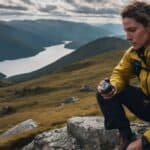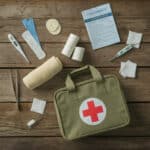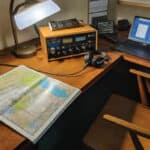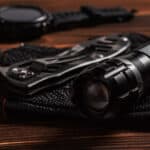Venturing into the wild brings unexpected challenges, especially when injuries happen far from medical help. A staggering number of outdoor enthusiasts lack fundamental first aid skills, risking their safety and that of others.
This article shines a light on must-know wilderness first aid essentials, equipping you with the knowledge to handle common trail mishaps confidently. Stay safe out there!
Table of Contents
Key Takeaways
- Wilderness first aid skills are crucial for anyone enjoying the outdoors, as they empower you to handle accidents and health issues effectively when medical help is not immediately available.
- Always have a well-stocked first aid kit with essentials like bandages, sterile gauze pads, tweezers, and pain relievers, but more importantly, know how to use each item properly.
- Learn basic emergency procedures like recognizing emergencies, assessing patient conditions with ABCDE steps (Airway, Breathing, Circulation Disability Exposure), performing CPR, and using an AED if necessary.
- Key treatments include cleaning wounds to prevent infection; applying RICE (Rest Ice Compression Elevation) for sprains or strains; wrapping burns loosely; and checking for ticks after time in wooded areas.
- Preparation is key: Before heading into the wilderness, take a course in first aid tailored specifically for unpredictable outdoor environments provided by organizations such as REI.
The Importance of First Aid Skills in Wilderness
Having first aid skills in the wilderness is like holding the key to survival; it empowers campers and hikers to respond effectively in case of accidents or sudden health issues. In environments where medical help isn’t just around the corner, knowledge of first aid becomes invaluable.
Handling sprains, managing wounds, and stabilizing fractures can mean the difference between a minor setback and a life-threatening situation.
Knowing how to use your wilderness first aid kit is crucial – it’s not enough to simply pack adhesive bandages or antiseptic wipes. You need the know-how of treating blisters without causing infections, recognizing signs of hypothermia before body temperature drops dangerously low, and performing CPR if someone experiences cardiac arrest far from professional help.
These skills aren’t just handy but essential parts of every outdoor enthusiast’s toolkit for staying safe while embracing nature’s unpredictability.
Initial Steps in Wilderness First Aid
Before diving into the depths of bandages and antibiotic ointments, it’s vital to understand the foundational steps one must take when faced with a medical emergency in the great outdoors.
Knowing how to recognize an urgent situation and readying yourself to administer first aid can mean the difference between swift recovery and severe complications.
Recognizing Emergencies
Recognizing emergencies means quickly identifying signs of major trauma or medical issues in the wild. This critical skill lets you act effectively to prevent a crisis from worsening.
Start by surveying the situation for immediate dangers, like wild animal encounters or hazards from a malfunctioning campfire. Keep an eye out for symptoms that need urgent attention: confusion, severe breathing difficulties, uncontrolled bleeding, and chest pain are clear red flags demanding swift action.
Assess individual conditions with care; if someone shows signs of heatstroke or an allergic reaction, these too can turn into life-threatening situations without proper medical attention.
It’s not just about spotting problems but also understanding their urgency – heart attack symptoms require CPR and possibly an automated external defibrillator (AED), while ankle injuries might need rest, ice, compression and elevation (RICE).
Ensure your responses match the seriousness of each scenario, as every second counts in preventing complications or even saving lives while far from professional help.
Preparing to Give First Aid
After recognizing an emergency, the next critical step is preparing to administer first aid effectively. This preparation can make a significant difference in the outcome for someone who is injured or ill.
- Start by ensuring your own safety before you approach to help; scan the area for any potential hazards.
- Equip yourself with gloves if available, as they protect both you and the patient from contamination.
- Identify and access your first aid kit; it should be stocked with essentials such as bandages, sterile gauze pads, tweezers, and pain relievers. See our first aid kit supplies list.
- If you’re part of a group, assign roles to others around you – someone should be ready to call for help while another might assist with first aid.
- Remain calm and reassuring to avoid panic; your demeanor can stabilize the situation for everyone involved, especially the patient.
- Understand that in wilderness settings, cell service may be unreliable; have a plan for signalling or reaching help if needed.
- Learn how to use all items within your first aid kit prior to your camping trip or day hike, ensuring you can apply them efficiently in case of an emergency.
- Familiarize yourself with CPR and AED usage – it’s a vital skill that could save lives during cardiac emergencies.
- Prepare for potential allergic reactions by packing appropriate medications and knowing how to administer them correctly.
- Consider the environmental conditions you will face on your adventure; pack items like sunburn relief creams with adequate SPF or an emergency blanket for colder climates.
Detailed Patient Assessment in Wilderness
In the unpredictable expanse of the wilderness, a detailed patient assessment can make all the difference in an emergency situation. This step is where survival skills meet medical knowledge, enabling you to gauge the severity of injuries or illnesses and prioritize your response effectively.
Initial Patient Assessment
Check immediately if the injured person can hear you. Ask for their permission to help, as consent is crucial before proceeding with any type of care. Evaluate their level of consciousness and look for signs that they understand what’s happening around them.
If the patient doesn’t respond, it’s time to use the “ABCDE” approach: Check whether there is anything obstructing the Airway; listen and feel for Breathing; assess Circulation by looking for bleeding or checking a pulse; determine Disability by observing movement or response to stimulus; and finally, Expose injuries so you can see all wounds clearly.
Ensure your own safety first — you won’t be helpful if you become a victim, too. Keep an eye on your surroundings while conducting initial assessments, especially since wilderness environments often come with hidden dangers.
Once completed, move forward confidently knowing next steps include a more in-depth evaluation during a Secondary Patient Assessment.
Secondary Patient Assessment
After completing the initial assessment, it’s time to dive deeper into secondary patient assessment. This step is about collecting detailed information to shape your treatment plan and decide whether you need to evacuate the patient.
You’ll want to ask them questions about their medical history, look for signs of allergies or any existing health problems that could affect their current condition. Pay close attention to how they breathe; shortness of breath can be a serious sign.
Carefully examine the individual from head to toe—this means checking for bruises, bone fractures, or swelling in areas like knees that might have been overlooked during the primary check.
Use your wilderness first aid training here; if you haven’t taken a class yet, consider enrolling in one offered by organizations such as REI, where secondary assessments are taught comprehensively.
Your goal is not just immediate care but also gathering critical data that healthcare professionals will need later on.
Essential Elements of a Wilderness First Aid Kit
Ensuring your wilderness first aid kit is properly stocked can be the difference between a minor setback and a critical emergency. It’s not just about having bandages and tweezers; it’s about being prepared for anything nature throws your way, tailoring contents to specific needs, and understanding how to use each item effectively.
Bandages
Bandages are versatile tools in any wilderness first aid kit, crucial for managing various injuries. Whether it’s wrapping a sprained ankle with an ACE bandage or using athletic tape to support a knee injury, knowing how to apply these materials properly is essential.
Courses in wilderness first aid emphasize the importance of effective bandaging techniques to control bleeding, protect wounds from infection, and stabilize injured limbs.
Properly applied sterile dressings and wraps can prevent further damage and assist in the healing process while awaiting more advanced medical help. These skills aren’t just for major accidents – even minor cuts and scrapes can become serious if not treated correctly in a backcountry setting.
Pack your first aid kit with an assortment of bandages; they’re indispensable when caring for wounds or providing support after twists or falls on hikes.
Tweezers
Moving beyond bandages, let’s consider the value of tweezers in your wilderness first aid kit. These simple tools are indispensable for precisely removing splinters, ticks, and other small debris that can lead to infection if not dealt with correctly.
Carrying tweezers on your outdoor adventures ensures you’re equipped to handle these common but pesky obstacles without causing additional harm to the skin.
Underestimating the importance of tweezers could be a mistake, as they play a critical role in maintaining hygiene when treating minor wounds. By using them carefully, you prevent bacteria from invading small cuts or punctures—safeguarding against infections that could turn a minor problem into a major complication under wilderness conditions.
Wilderness First Aid: Treatment Plan and Tips
Creating a solid treatment plan in the wilderness begins with knowing how to respond to different types of emergencies. For cuts and scrapes, clean the wound thoroughly with clean water or an antibacterial solution to prevent infection.
If you’re dealing with sprains or strains, remember the acronym RICE: Rest, Ice, Compression, and Elevation – this can significantly reduce swelling and pain. In cases of insect bites and stings, gentle application of creams containing aloe vera can soothe irritation while regular checks for ticks should be part of your routine after hiking through wooded areas.
Keeping calm is crucial when managing any medical situation outdoors. Start by assessing the severity of injuries – if someone has sustained a fracture or potential heat stroke, it’s important not only to stabilize them but also to determine if evacuation is necessary.
Always wrap burns loosely with sterile dressings from your first aid kit to shield damaged skin from further injury and infection. Be prepared to perform CPR if someone shows no signs of breathing or circulation; quick action could save their life before professional help arrives.
Heat-related illnesses require immediate attention, too; move the person to shade promptly and encourage sipping water if they are conscious and able to swallow safely.
Conclusion
Stepping into the wild brings adventure and unpredictability, making first aid knowledge a camper’s best friend. Equip yourself with essential skills to tackle medical emergencies, and always pack a comprehensive first aid kit.
Embrace the confidence that comes from being prepared; it’s the companion every outdoor enthusiast needs. Let your wilderness experiences be memorable for all the right reasons. Stay safe, stay informed, and enjoy every moment of your journey under the open sky!
Is Knowing Survival Signaling Important for Wilderness First Aid?
Knowing how to signal distress in wilderness is crucial for wilderness first aid. In emergency situations, being able to effectively communicate for help can make a life-saving difference. Understanding and utilizing signaling techniques can increase the chances of being located and rescued in urgent situations.
FAQs
What should I have in my first aid kit for camping?
Pack your first aid kit with essential items like bandages, antiseptic wipes, and supplies for CPR to manage medical emergencies while enjoying the wilderness.
How do I treat a sunburn while camping?
If you get a sunburn, stay out of the sun, gently apply cool compresses to soothe the skin, and use aloe or moisturizers to keep the area hydrated.
Can you tell me how to safely extinguish a campfire?
To safely put out your campfire, douse it thoroughly with water, stir the ashes until cold, and make sure all embers are extinguished before leaving the site.
Why is food safety important when backpacking?
Keeping your food safe prevents infection by ensuring what you eat is free from harmful bacteria that could cause illness far away from immediate medical help.
What are some signs of shock in an injured person during a hike?
Look for symptoms like confusion, clammy skin or rapid breathing in someone who’s injured — these can indicate shock which requires keeping them warm and their blood flowing properly until help arrives.













Leave a Reply